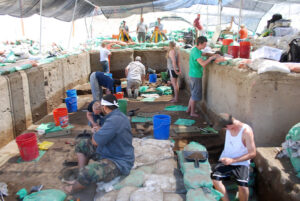
AMERICAN ASSOCIATION FOR THE ADVANCEMENT OF SCIENCE (AAAS)—Radiocarbon dating indicates that 13 projectile point stone tools found at the Cooper’s Ferry site in present-day western Idaho are 2,300 years older than others previously unearthed at the site, expanding the time frame for tool use in this community. The work also refines the inhabitancy time frame for Paleoamericans in an archaeological settlement in the Columbia River basin. “This discovery significantly expands both the radiocarbon chronology of human occupation in the Americas and our knowledge of the technological traditions employed by its early inhabitants,” Loren Davis and colleagues write. Before the Clovis people – who are famed for using specialized stone tools with fluted points – there were other Paleoamericans who also used stemmed point technology. Past work by members of the same research group established the presence of one such community at Cooper’s Ferry that consistently inhabited the settlement beginning sometime between 16,560 and 15,280 B.P. Now, Davis et al.* has used radiocarbon dating on 13 stemmed points gathered from an excavation site called Area B within Cooper’s Ferry to glean new insights about this community, their tool use, and their possible origins. In addition to confirming the period during which Cooper’s Ferry was inhabited, an examination of artifacts from Area B also revealed novel stemmed point tools dated to be 2,300 years older than those found in an excavation site in the settlement known as Area A. The identification of older projectile point tools shows that these techniques were in use at Cooper’s Ferry before there was an ice-free corridor in the Americas. The absence of a land route through which this technology could have spread suggested to the authors that such knowledge may have come from across the Pacific. Hence, the team compared Cooper’s Ferry stemmed point technology with that found in paleo-communities in Japan. “These bifacial stemmed point technologies occur well before the appearance of different lithic and ceramic technologies associated with incipient Jomon occupations in Hokkaido,” the authors write, noting that the Jomon settlement emerged around 14,700 B.P. “We hypothesize this shared similarity in pre-Jomon stemmed point technology may point to the general location along the northwest Pacific Rim from which some of the earliest peoples in the Americas may have originated between ~22,000-16,000 years ago.”

Cooper’s Ferry Site 2013 Area A looking east. Loren Davis, Oregon State University
*Dating of a Large Tool Assemblage at the Cooper’s Ferry Site (Idaho, USA) Dated ~15,785 cal yr B.P. Extends Age of Stemmed Points in the Americas, Science Advances, 23-Dec-2022. 10.1126/sciadv.ade1248
________________________________
Advertisement

Don’t miss out on this unforgettable evening as Dr. Hawass reveals the most closely guarded secrets of ancient Egypt and presents his groundbreaking new discoveries and latest research live on stage. As the man behind all major discoveries in Egypt over the last few decades and director of several ongoing archaeological projects, Dr. Hawass may yet surprise you with unexpected revelations that will make news across the world.
_______________________________
Advertisement



